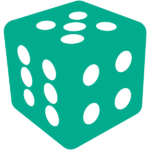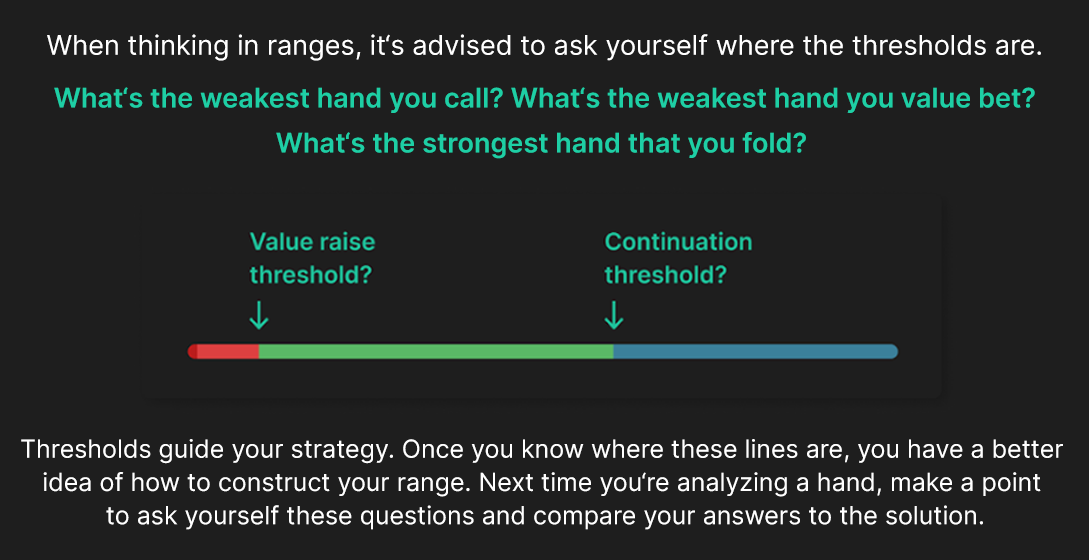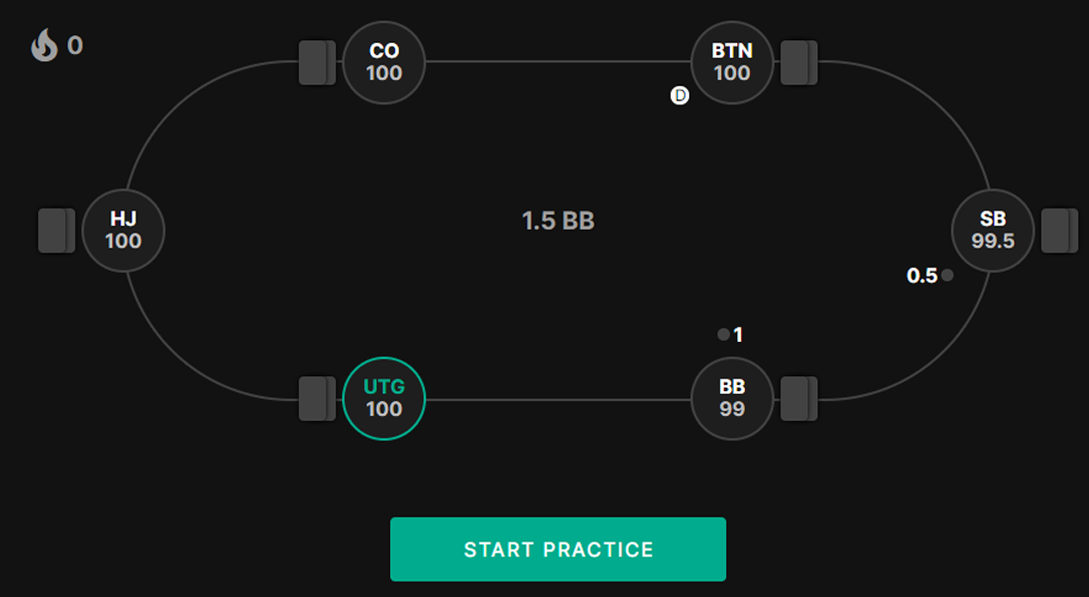The 10 Most Important Concepts for New Poker Players
If you don’t understand some terms in this article, learn more about them in our Poker Glossary.
1. Mechanics of game theory
Fundamentals are one of the most important points when starting out. While many old-school players learned by feel, this style of play rarely works outside of the softest games in today’s poker economy.
Start by learning the mathematical fundamentals of game theory, such as pot odds, stack-to-pot ratio (SPR)Stack-to-Pot Ratio (SPR)
The effective stack divided by the size of the pot. SPR is commonly used to gauge the value of implied odds and the relative value of made hands., equityEquity
The percentage chance that a player will win a hand, assuming all players go to showdown. Equity also factors in ties. Equity can be calculated in multiple ways, such as: hand vs hand, hand vs range, or range vs range. Equity more loosely refers to the value of a hand, however, factors such as equity realization can influence the expected value of a hand., expected valueExpected Value (EV)
The anticipated value one expects from any hand, position, or play. EV is calculated as a weighted average of all possible outcomes weighed by the probability of each of those outcomes., Minimum Defense Frequency (MDF)Minimum Defense Frequency (MDF)
The minimum percentage of your range that must be defended against a bet to prevent the opponent from profitably bluffing a 0% equity hand. Inversely related to alpha; MDF = 1 – alpha. MDF = 1/(s+1) where ‘s’ is the percentage of the pot that is bet. For example, if villain bets half-pot, hero needs to defend 1/(0.5+1) = 66% of their range in order to remain unexploitable against a pure bluff., and equity realizationEquity Realization (EQR)
The ability of a hand to “realize” its raw equity. Generally, Equity Realization (EQR) has come to mean the translation of raw equity to expected value. A hand that wins more than its equity would suggest is said to “over-realize” its equity. A hand that wins less often than its equity suggests is said to “under-realize” its equity. Mathematically, equity realization is typically defined as EQR = pot-share / equity, where pot-share is the expected percentage of the pot a hand will win according to its expected value, and equity is the raw equity of a hand if checked to showdown. For example, a hand that wins (on average) 70% of the pot, which only has 40% raw equity, has an equity realization factor (EQR) of 0.7 / 0.4 = 175%.. You don’t need to be a mathematician, and you don’t need to be calculating at the tables. But you do need a sense of how this game’s mechanics actually work to become successful.
You need to understand what hand strength (relative to the board texture) is appropriate for what line you’re taking. Stacking off in a 20 SPR pot with top pair no kicker is seldom warranted. Folding a set just because a two-card straight is possible is almost never going to be correct in a low SPR situation. You need an idea of what is appropriate. How do you develop these senses? Well, start with thresholds!
2. Thresholds
One of the fastest ways to become a reasonably solid poker player is by studying thresholds. Which hand classes are reasonable to stack off with in this spot? What hands can reasonably raise for value? What hand classes need to continue vs. this bet?
Beginners almost always misevaluate these thresholds, commonly by overvaluing medium-strength hands. So the next time you review a GTO solution, go out of your way to find these value and continuation thresholds. It’s much easier to learn a simple line in the sand than memorize entire ranges.
3. It’s not about your hand, it’s about how you play your entire range
Common trap beginners fall into is obsessing over the frequencies of individual hands. The problem with this approach is that it’s simply impossible to memorize all frequencies for every spot. This is a wildly inefficient method of training.
A much better approach involves taking a step back and looking at things holistically. Look at your entire range. You need to construct something that involves the correct amount of bluffs and value relative to your actions. Even if your frequencies are incorrect, it’s the overall construction of your range that actually matters. Check out our YouTube channel for examples of how to do this.
4. Winning the pot more often is not the same thing as maximizing EV
The human mind tends to remember losses more strongly than wins. This often causes a bias, tempting people to try and win the pot immediately instead of making the highest EV play. Sometimes the best play involves taking a line that either wins a huge pot and more often than not loses a small pot.
 Let’s say we rolled a dice. If we roll a 1-5 you give me $10. If we roll a 6, I give you $100. 83% of the time you’ll lose $10, but 17% of the time you’ll win $100.
Let’s say we rolled a dice. If we roll a 1-5 you give me $10. If we roll a 6, I give you $100. 83% of the time you’ll lose $10, but 17% of the time you’ll win $100.
Your EV in this game is extremely high, EV = (⅙ * $100 – ⅚ * $10) = + $8.33 per roll.
As you can see, winning more often isn’t necessarily the highest EV play. Sometimes, you need to take a high-EV, low-frequency longshot. Sometimes you need to check vulnerable made hands and let your opponent draw. Retrain your mind to overcome this bias.
5. Stop overvaluing big cards
Most recreational players massively overvalue big cards. As a result, they’ll often play very top-heavy ranges, causing them to make a lot of dominated pairs and run into reverse implied odds situations more often.
In poker, implied odds are everything, especially if you play cash games 100bb deep. The ability to draw to the nuts and withstand multiple streets of aggression often far outweighs the value you can obtain with a dominated top pair. Many beginners are surprised to see that GTO often folds hands like AJo to a 3bet, choosing instead to continue with hands with better implied odds such as suited connectors or pocket pairs.
A typical leak is overplaying big pairs, often well beyond their actual value given the board texture. Part of this is psychological; aces is somehow a magical hand that “deserves” to get paid off in stacks. The top pair good kicker cannot get outdrawn again. Two-pair is somehow unfoldable despite all the draws getting there and the opponent checking the river. This behavior often limits the value of these premium hands when played by a novice. At the end of the day, it’s just one pair.
6. Most of your EV comes from nutted hands
Nutted hands make up the majority of your expected value. This becomes truer as you play deeper. The fact is that the *vast* majority of hands are very close to breakeven, so it’s paramount to learn to play your nutted hands correctly.
Here we can see the expected value of combinations when folded to the BTN in a 100bb cash game. The BTN opens 42% of hands. About half of all hands opened in this spot expect to make less than 0.1bb in the long run.
The same holds true postflop. Most of your expected value is generated by the few nutted hands you have in range. This is why it’s so important to learn how to play your nutted hands well.
7. Start by mastering your preflop strategy
Mastering preflop is the quickest and most efficient way to improve your results drastically. Playing preflop well translates into playing postflop well. Everything stems from this street. Luckily, preflop solutions are readily available for free, and GTO Wizard offers several training modes to hone your preflop skills.
Make your preflop strategy automatic. This allows you to confidently put in more volume, make fewer mistakes, and sets you up to play well on future streets. Try our GTO Trainer for free!
8. Most of your heuristics are based on lies
Almost every heuristic you’ve ever come up with is inevitably based on biased assumptions. Your perception of a winning play is skewed by the meta in which you play, and subconscious factors like risk aversion will bias your strategy. When you read a solver, your brain will try to rationalize the strategy to fit your own worldview rather than trying to expand your theory. This is very human, and it takes training to overcome.
To truly grow as a poker player, you often need to let go of old habits and broaden your horizons. This is especially true for those new to the world of solvers and game theory optimal play. Try to challenge your assumptions. Go out of your way to look for counterexamples to your theories. The goal is to expand your mind rather than reinforcing your current view.
9. Variance is much bigger than the human mind can conceptualize
The gambler’s fallacy is very common among poker players. Let’s say we flip a fair coin, and it lands on heads 6 times in a row. What is the probability that it lands on heads the next flip?
If you’re superstitious, you might think you are “owed” tails. But that’s simply not how reality works. The next flip is 50%/50%. You’re just as likely to flip a 7th heads as you were to flip heads the first time.

After thousands of flips we would expect heads and tails to even out. But that’s not because of some universal Karma; it’s simply the law of large numbers. Imagine we flip 1000 times and heads retains the 6-flip lead. At this point, we’ve flipped 503 heads and 497 tails – this is actually the expected value when starting with a 6-point lead. At this point, it’s 50.3% heads, 49.7% tails.
Now imagine we flip 100,000 times and retain the same 6 point lead. Now it’s 50.0003% heads and 49.9997% tails. The “luck” appears to even out despite tails never catching up. This is the law of large numbers.
Similarly, just because you’ve had bad luck doesn’t mean you are “owed” any rungood. The deck owes you nothing. Each hand is an independent event without memory of how you got your aces cracked.
The opposite is also true. Just because you’ve run well doesn’t mean you’re owed any bad luck. The truth is that variance in poker is far beyond what humans are capable of truly conceptualizing. If you’ve ever played around with a poker variance calculator, you’d find that it takes tens of thousands of hands before you can see a statistically significant edge materialize. We’ll discuss poker variance calculators more in future articles.
10. Stop overplaying medium-strength hands
One of the most common leaks among weak aggressive players are those that don’t have a medium-strength showdown value range.
This player type constantly overextends themself and is terrified of getting outdrawn. They have two ranges: the give-up range, and everything else gets the gas pedal.
They never win at showdown with marginal hands because those hands either bet so aggressively that they fold out the opponent, or get to showdown against a narrow range that has them crushed. They have no real trapping range; their passive lines are almost always dominated.
The problem with overplaying medium hands is that you often just end up folding out worse and getting called by better. It’s a very inefficient way to organize your equity. This style really only works well against calling stations. It’s easy to exploit.
You don’t need to keep firing every made hand just because there’s a draw on the board. Work on developing a medium-strength, “showdown value”, “pot-control” range.
We also made a video on this theme. You can watch it below:
Author
Tombos21
Tom is a long time poker theory enthusiast, GTO Wizard coach and YouTuber, and author of the Daily Dose of GTO.



















































































































































































































































